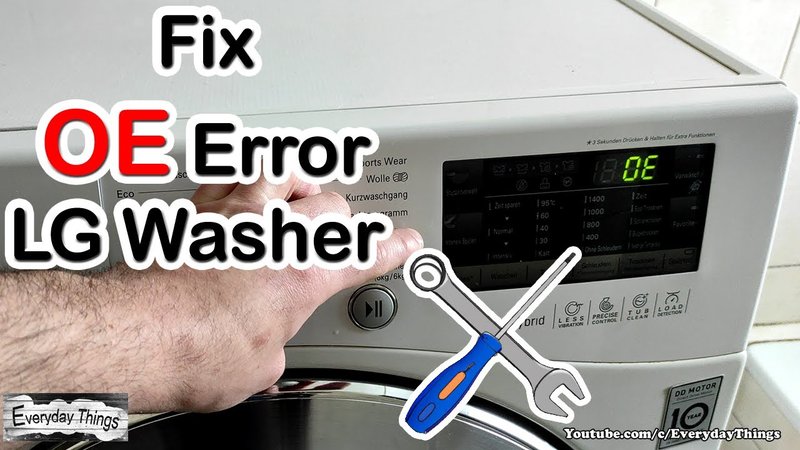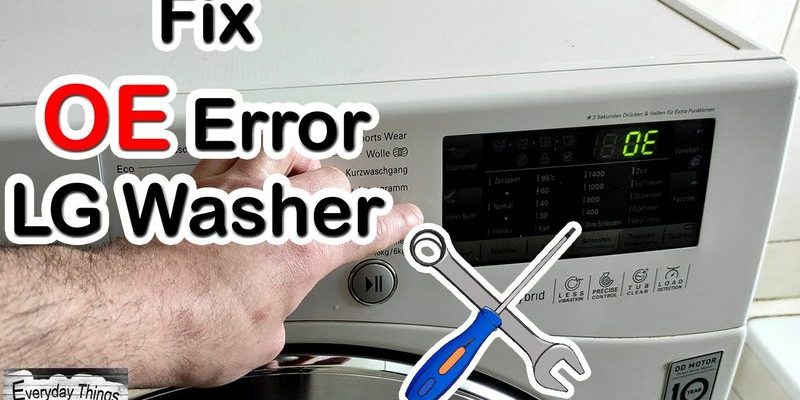
Now, you might be thinking, “Is it really a big deal if I ignore this?” Well, it is. Not fixing the error can lead to your clothes not getting properly washed, or worse, it could damage your machine over time. Just as a small crack in a dam will slowly turn into a gushing flood, the OE error, if left unchecked, could spiral into more costly repairs or even the need for a new machine entirely. Understanding what’s happening inside your machine with this error can empower you to make informed choices, ensuring your clothes stay clean and your machine in tip-top shape.
Understanding the LG Washing Machine Error OE
First, let’s break down what the OE error is all about. The OE in this context stands for “Outlet Error,” meaning your LG washing machine is having trouble draining water. Imagine a bathtub that you can’t empty — water just sits there, and your clothes can’t rinse properly. This error is essentially your washing machine’s way of saying, “Help! I can’t get rid of the water!” It’s usually triggered when the machine detects that it hasn’t drained all the water within the set time frame during a cycle.
So, what causes this drainage problem? The most common culprits are blockages in the filter or drain hose. It’s a bit like having a blocked straw where no matter how hard you try, nothing comes through. Other times, it might be a kink in the hose or an issue with the pump that helps expel water. If your machine is struggling to evacuate water, the OE error code appears as a call to action for you.
Here’s the deal: ignoring this error doesn’t make it disappear. Instead, it can get worse, leading to a washing machine that either doesn’t clean your clothes properly or stops working entirely. Plus, letting water stay stagnant can lead to unpleasant odors, much like water left standing in a puddle for too long. To keep your machine running smoothly, addressing this issue promptly is key.
Potential Consequences of Ignoring the OE Error
You might be wondering, “What if I just keep using the washing machine as is?” Let’s explore the consequences to give you a clearer picture. First and foremost, your clothes won’t be as clean. Imagine trying to wash your dishes in murky water — not exactly hygienic, right? The same goes for clothes; they need clean water to rinse out dirt and detergent effectively.
Beyond cleanliness, there’s also the risk of long-term damage to your machine. Consistently using a machine with drainage issues is like driving a car with a failing transmission — you’re setting the stage for a breakdown. Over time, stress on the pump and motor can lead to costly repairs. This might mean not just fixing the drainage issue but also replacing parts that are damaged due to neglect.
Another less obvious consequence is the increased electricity and water bills. When a machine doesn’t function efficiently, it often needs more time and energy to complete cycles. In the long run, this inefficiency can lead to higher utility costs. To avoid these pitfalls, it’s wise to tackle the OE error sooner rather than later.
How to Fix the OE Error
Let’s dive into some straightforward solutions for fixing the OE error. The simplest step is to check the drain hose for any twists or kinks. Picture it like a garden hose — a kink can stop water flow in its tracks. If the hose is obstructed, straighten it out and see if this solves the problem.
Next, inspect the drain filter. Over time, it can accumulate debris, much like lint collecting in a dryer filter. Remove any blockages you find, wash the filter with water, and put it back carefully. If you’re comfortable doing so, you can also check the drain pump, which may require removing the washer’s back panel. This can be a bit trickier, so proceed only if you feel confident.
Finally, if these steps don’t resolve the issue, it might be time to call in a professional. Think of it like taking a malfunctioning laptop to a technician — sometimes expert intervention is necessary. A repair technician will have the tools and expertise to diagnose and fix more complex problems, ensuring your machine is back in working order.
Preventative Tips to Avoid the OE Error
Prevention, as they say, is better than cure. To keep the OE error from occurring in the future, regular maintenance is crucial. Make it a habit to clean the drain filter every few months. This is like clearing out cobwebs before they become a bigger mess. Also, check the drain hose periodically for blockages or kinks.
Another tip is to avoid overloading your washing machine. Picture a backpack stuffed with too many books — it’s going to strain the zippers. Overloading can lead to poor drainage, which may trigger the OE error. Always follow the manufacturer’s guidelines for load sizes.
Lastly, consider running a maintenance wash every month. Using a washing machine cleaner helps keep the drum and internal parts in good shape, reducing the likelihood of issues. Taking these preventative steps can keep your washing machine happy and your laundry routine hassle-free.
In conclusion, while the OE error may be frustrating, it’s far from insurmountable. Addressing it promptly not only saves you from future headaches but ensures your washing machine continues to serve you faithfully. So the next time you see that OE code, you’ll know just what to do to keep your machine running smoothly.
